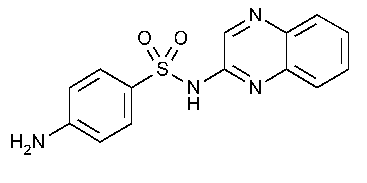Sulfaquinoxaline
»Sulfaquinoxaline contains not less than 98.0percent and not more than 101.0percent of C14H12N4O2S,calculated on the dried basis.
Packaging and storage—
Preserve in well-closed containers,protected from light.
Labeling—
Label it to indicate that it is for veterinary use only.
Identification—
A:
Infrared Absorption á197Kñ.
Solution:
10µg per mL.
Medium:
0.01Nsodium hydroxide.
C:
Dissolve 4mg in 2mLof 2Nhydrochloric acid,add 0.2mLof sodium nitrite solution (1in 100),and allow to stand for 2minutes.Add the solution to 1mLof 2-naphthol TS:an orange-red precipitate is formed.
Acidity—
Digest 2g of it with 100mLof water at about 70 for 5minutes,cool to about 20
for 5minutes,cool to about 20 ,and filter.Titrate 50mLof the filtrate with 0.1Nsodium hydroxide VSto a pHof 7.0:not more than 0.2mLis required.
,and filter.Titrate 50mLof the filtrate with 0.1Nsodium hydroxide VSto a pHof 7.0:not more than 0.2mLis required.
Loss on drying á731ñ—
Dry it at 105 for 4hours:it loses not more than 1.0%of its weight.
for 4hours:it loses not more than 1.0%of its weight.
Residue on ignition á281ñ:
not more than 0.1%.
Heavy metals,Method IIá231ñ:
0.002%.
Related compounds—
Dissolve 400mg of Sulfaquinoxaline in 4mLof 1Nsodium hydroxide,add methanol to obtain 100mLof solution,and mix (test solution).Prepare a solution of USP Sulfaquinoxaline Related Compound A RSin methanol containing 0.12mg per mL(Standard solution 1).Prepare a solution of sulfanilamide in methanol containing 0.04mg per mL(Standard solution 2).Separately apply 5µLeach of the test solution,Standard solution 1,and Standard solution 2to a thin-layer chromatographic plate (see Chromatography á621ñ)coated with a 0.25-mm layer of chromatographic silica gel mixture.Allow the spots to dry,and develop the chromatogram in a solvent system consisting of a mixture of chloroform,methanol,and ammonium hydroxide (60:40:20)until the solvent front has moved about three-fourths of the length of the plate.Remove the plate from the chamber,mark the solvent front,allow it to air-dry,and examine the plate under short-wavelength UVlight:no spot corresponding to sulfaquinoxaline related compound Ain the chromatogram obtained from the test solution is more intense than the principal spot in the chromatogram obtained from Standard solution 1(3.0%),and no spot,other than the principal spot and the sulfaquinoxaline related compound Aspot,if any,in the chromatogram obtained from the test solution is more intense than the principal spot in the chromatogram obtained from Standard solution 2(1.0%).
Assay—
Mobile phase—
Dissolve 2g of monobasic ammonium phosphate in 1000mLof a mixture of water,acetonitrile,glacial acetic acid,tetrahydrofuran,and ammonium hydroxide (583:400:10:5:2).Filter through a filter of 0.5µm or finer porosity,and degas.Make adjustments if necessary (see System suitabilityunder Chromatography á621ñ).
Standard preparation—
Dissolve an accurately weighed quantity of USP Sulfaquinoxaline RSin 0.01Nsodium hydroxide to obtain a solution having a known concentration of about 0.7mg per mL.
Assay preparation—
Transfer about 175mg of Sulfaquinoxaline,accurately weighed,to a 250-mLvolumetric flask,dilute with 0.01Nsodium hydroxide to volume,and mix.
Chromatographic system
(see Chromatography á621ñ)—The liquid chromatograph is equipped with a 254-nm detector and a 4-mm ×25-cm column that contains packing L1.The flow rate is about 1mLper minute.Chromatograph the Standard preparation,and record the peak responses as directed for Procedure:the column efficiency is not less than 2500theoretical plates,the tailing factor is not more than 1.2,and the relative standard deviation for replicate injections is not more than 2.0%.
Procedure—
Separately inject equal volumes (about 15µL)of the Standard preparationand the Assay preparationinto the chromatograph,record the chromatograms,and measure the responses for the major peaks.Calculate the quantity,in mg,of C14H12N4O2Sin the portion of Sulfaquinoxaline taken by the formula:
250C(rU/rS),
in which Cis the concentration,in µg per mL,of USP Sulfaquinoxaline RSin the Standard preparation,and rUand rSare the sulfaquinoxaline peak responses obtained from the Assay preparationand the Standard preparation,respectively.
Auxiliary Information—
Staff Liaison:Ian DeVeau,Ph.D.,Senior Scientist
Expert Committee:(VET)Veterinary Drugs
USP28–NF23Page 1832
Phone Number:1-301-816-8178
